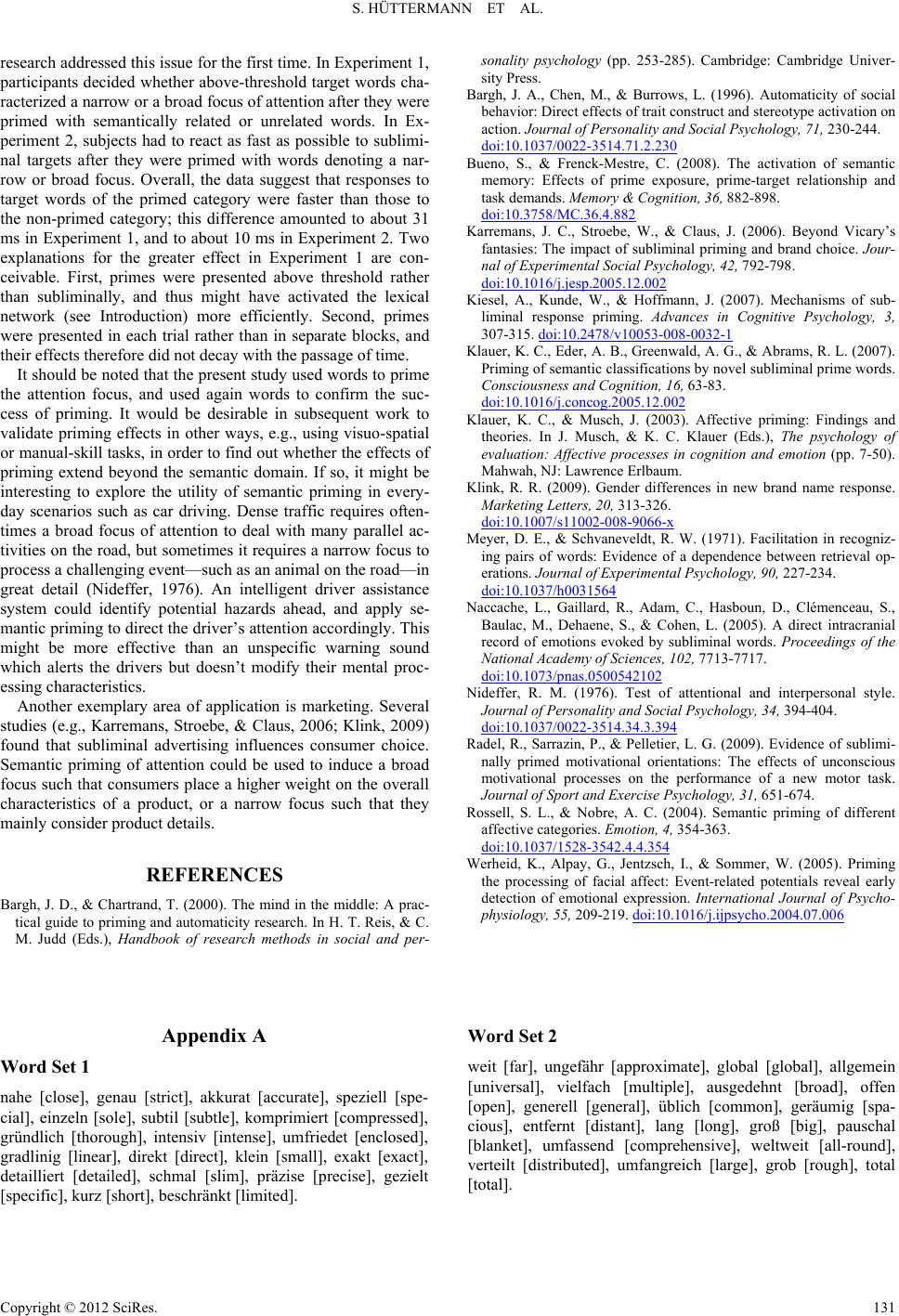
S. HÜTTERMANN ET AL.
Copyright © 2012 SciRes. 131
research addressed this issue for the first time. In Experiment 1,
participants decided whether above-threshold target words cha-
racterized a narrow or a broad focus of attention after they were
primed with semantically related or unrelated words. In Ex-
periment 2, subjects had to react as fast as possible to sublimi-
nal targets after they were primed with words denoting a nar-
row or broad focus. Overall, the data suggest that responses to
target words of the primed category were faster than those to
the non-primed category; this difference amounted to about 31
ms in Experiment 1, and to about 10 ms in Experiment 2. Two
explanations for the greater effect in Experiment 1 are con-
ceivable. First, primes were presented above threshold rather
than subliminally, and thus might have activated the lexical
network (see Introduction) more efficiently. Second, primes
were presented in each trial rather than in separate blocks, and
their effects therefore did not decay with the passage of time.
It should be noted that the present study used words to prime
the attention focus, and used again words to confirm the suc-
cess of priming. It would be desirable in subsequent work to
validate priming effects in other ways, e.g., using visuo-spatial
or manual-skill tasks, in order to find out whether the effects of
priming extend beyond the semantic domain. If so, it might be
interesting to explore the utility of semantic priming in every-
day scenarios such as car driving. Dense traffic requires often-
times a broad focus of attention to deal with many parallel ac-
tivities on the road, but sometimes it requires a narrow focus to
process a challenging event—such as an animal on the road—in
great detail (Nideffer, 1976). An intelligent driver assistance
system could identify potential hazards ahead, and apply se-
mantic priming to direct the driver’s attention accordingly. This
might be more effective than an unspecific warning sound
which alerts the drivers but doesn’t modify their mental proc-
essing characteristics.
Another exemplary area of application is marketing. Several
studies (e.g., Karremans, Stroebe, & Claus, 2006; Klink, 2009)
found that subliminal advertising influences consumer choice.
Semantic priming of attention could be used to induce a broad
focus such that consumers place a higher weight on the overall
characteristics of a product, or a narrow focus such that they
mainly consider product details.
REFERENCES
Bargh, J. D., & Chartrand, T. (2000). The mind in the middle: A prac-
tical guide to priming and automaticity research. In H. T. Reis, & C.
M. Judd (Eds.), Handbook of research methods in social and per-
sonality psychology (pp. 253-285). Cambridge: Cambridge Univer-
sity Press.
Bargh, J. A., Chen, M., & Burrows, L. (1996). Automaticity of social
behavior: Direct effects of trait construct and stereotype activation on
action. Journal of P e rsonality and Social Psychology, 71, 230-244.
doi:10.1037/0022-3514.71.2.230
Bueno, S., & Frenck-Mestre, C. (2008). The activation of semantic
memory: Effects of prime exposure, prime-target relationship and
task demands. Memory & Cognition, 36, 882-898.
doi:10.3758/MC.36.4.882
Karremans, J. C., Stroebe, W., & Claus, J. (2006). Beyond Vicary’s
fantasies: The impact of subliminal priming and brand choice. Jour-
nal of Experimental Social P s y c ho l o gy, 42, 792-798.
doi:10.1016/j.jesp.2005.12.002
Kiesel, A., Kunde, W., & Hoffmann, J. (2007). Mechanisms of sub-
liminal response priming. Advances in Cognitive Psychology, 3,
307-315. doi:10.2478/v10053-008-0032-1
Klauer, K. C., Eder, A. B., Greenwald, A. G., & Abrams, R. L. (2007).
Priming of semantic classifications by novel subliminal prime words.
Consciousness and Cognition, 16, 63-83.
doi:10.1016/j.concog.2005.12.002
Klauer, K. C., & Musch, J. (2003). Affective priming: Findings and
theories. In J. Musch, & K. C. Klauer (Eds.), The psychology of
evaluation: Affective processes in cognition and emotion (pp. 7-50).
Mahwah, NJ: Lawrence Erlbaum.
Klink, R. R. (2009). Gender differences in new brand name response.
Marketing Letters, 20, 313-326.
doi:10.1007/s11002-008-9066-x
Meyer, D. E., & Schvaneveldt, R. W. (1971). Facilitation in recogniz-
ing pairs of words: Evidence of a dependence between retrieval op-
erations. Journal of Experimental Psyc hology , 90, 227-234.
doi:10.1037/h0031564
Naccache, L., Gaillard, R., Adam, C., Hasboun, D., Clémenceau, S.,
Baulac, M., Dehaene, S., & Cohen, L. (2005). A direct intracranial
record of emotions evoked by subliminal words. Proceedings of the
National Academy of Sciences, 1 02 , 7713-7717.
doi:10.1073/pnas.0500542102
Nideffer, R. M. (1976). Test of attentional and interpersonal style.
Journal of Personality a nd Social Psychology, 34, 394-404.
doi:10.1037/0022-3514.34.3.394
Radel, R., Sarrazin, P., & Pelletier, L. G. (2009). Evidence of sublimi-
nally primed motivational orientations: The effects of unconscious
motivational processes on the performance of a new motor task.
Journal of Sport and Exercise P s yc holo gy, 31, 651-674.
Rossell, S. L., & Nobre, A. C. (2004). Semantic priming of different
affective categories. Emotion, 4, 354-36 3.
doi:10.1037/1528-3542.4.4.354
Werheid, K., Alpay, G., Jentzsch, I., & Sommer, W. (2005). Priming
the processing of facial affect: Event-related potentials reveal early
detection of emotional expression. International Journal of Psycho-
physiology, 55, 209-219. doi:10.1016/j.ijpsycho.2004.07.006
Appendix A
Word Set 1
nahe [close], genau [strict], akkurat [accurate], speziell [spe-
cial], einzeln [sole], subtil [subtle], komprimiert [compressed],
gründlich [thorough], intensiv [intense], umfriedet [enclosed],
gradlinig [linear], direkt [direct], klein [small], exakt [exact],
detailliert [detailed], schmal [slim], präzise [precise], gezielt
[specific], kurz [short], beschränkt [limited].
Word Set 2
weit [far], ungefähr [approximate], global [global], allgemein
[universal], vielfach [multiple], ausgedehnt [broad], offen
[open], generell [general], üblich [common], geräumig [spa-
cious], entfernt [distant], lang [long], groß [big], pauschal
[blanket], umfassend [comprehensive], weltweit [all-round],
verteilt [distributed], umfangreich [large], grob [rough], total
[total].